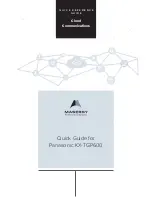
DRAFT
© 2003 - 2005 Sipura Technology, Inc
Proprietary (See Copyright Notice on Page 2)
67
Configuration Profile
The SPA-841 configuration profile can take one of two forms: a compact binary file, or an XML text file.
By convention, the profile is named with the extension “.cfg” (e.g. spa841.cfg). In the case of a binary
profile, the Sipura Profile Compiler tool (SPC) is provided by Sipura for compiling a plain-text file
containing parameter-value pairs into a properly formatted (and optionally encrypted) CFG file. The spc
tool is available from Sipura for the Win32 environment (spc.exe), and the Linux-i386-elf environment
(spc-linux-i386-static). In the case of an XML text profile, the XML file itself is fed to the SPA-841 directly,
without prior compilation into a binary form. The XML text profile function is an advanced feature,
described in the SPA Provisioning Guide.
The syntax of the source plain-text file accepted by the Sipura Profile Compiler is a series of parameter-
value pairs, with the value enclosed in double quotes. Each parameter-value pair is followed by a
semicolon, thus:
Parameter_Name “parameter value”;
For example:
Proxy[1] “sip.service.com”;
Register_Expires[1] “900”;
A sample source plain-text profile can be generated from the SPC tool with the following command-line
invocation:
spc.exe --sample-profile sample.txt
The sample.txt can then be edited as appropriate for the administrator’s network, and compiled into a
binary profile with this SPC command-line invocation:
spc.exe sample.txt sample.cfg
If no quoted value is specified for a parameter (or if a parameter specification is missing entirely from the
source plain-text file) the value of the parameter will remain unchanged in the SPA-841 when the SPA-
841 resyncs to the compiled binary profile.
The syntax also controls the parameter’s user-level access when using the built-in web interface to the
SPA. An optional exclamation point or question mark, immediately following the parameter name,
indicates the parameter should be user read-write or read-only, respectively. If neither mark is present,
the parameter is made inaccessible to the user from the web interface. Note that this syntax has no
effect on the admin-level access to the parameters.
Typical usage would be as in the following example:
Par1 “123” ;
Par2 ! ;
Here, Par1 is managed by the administrator through remote provisioning, and is only visible in the admin-
login webUI (http://spa-ip-addr/admin/advanced). On the other hand, Par2 is managed by the end-user,
is visible in the user-login webUI (http://spa-ip-addr/advanced), and is unaffected by periodic resyncs to
the provisioning server.













































